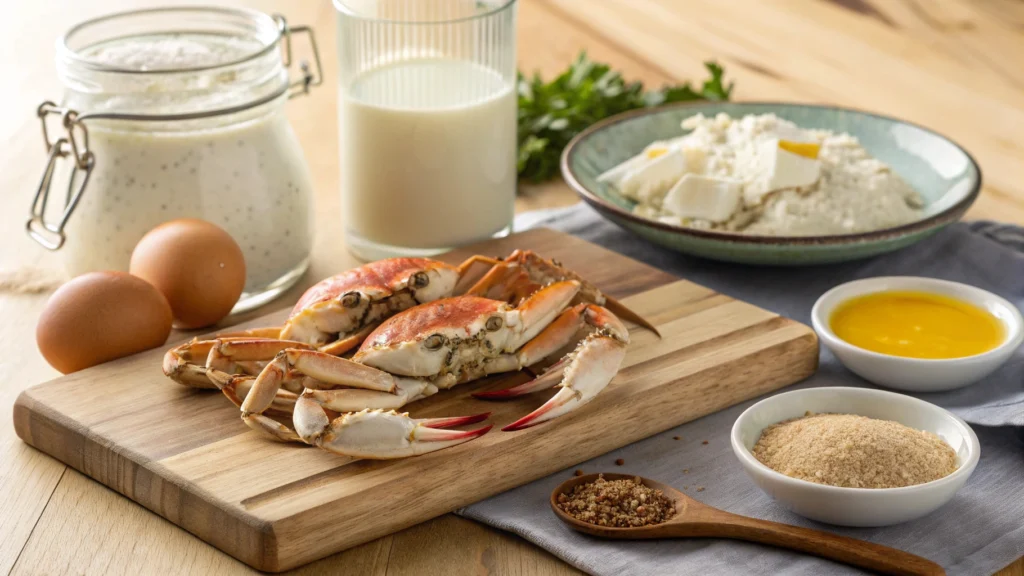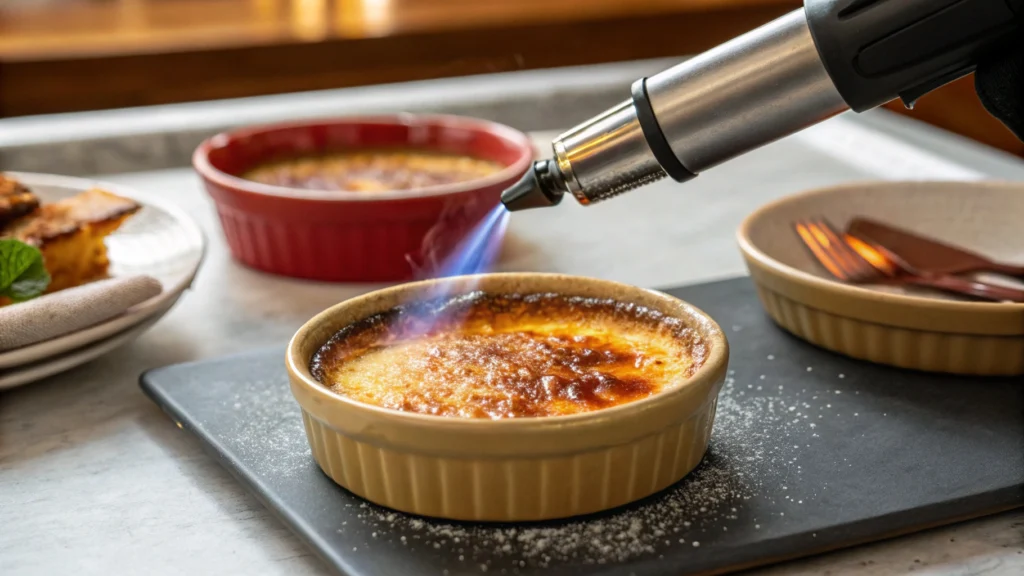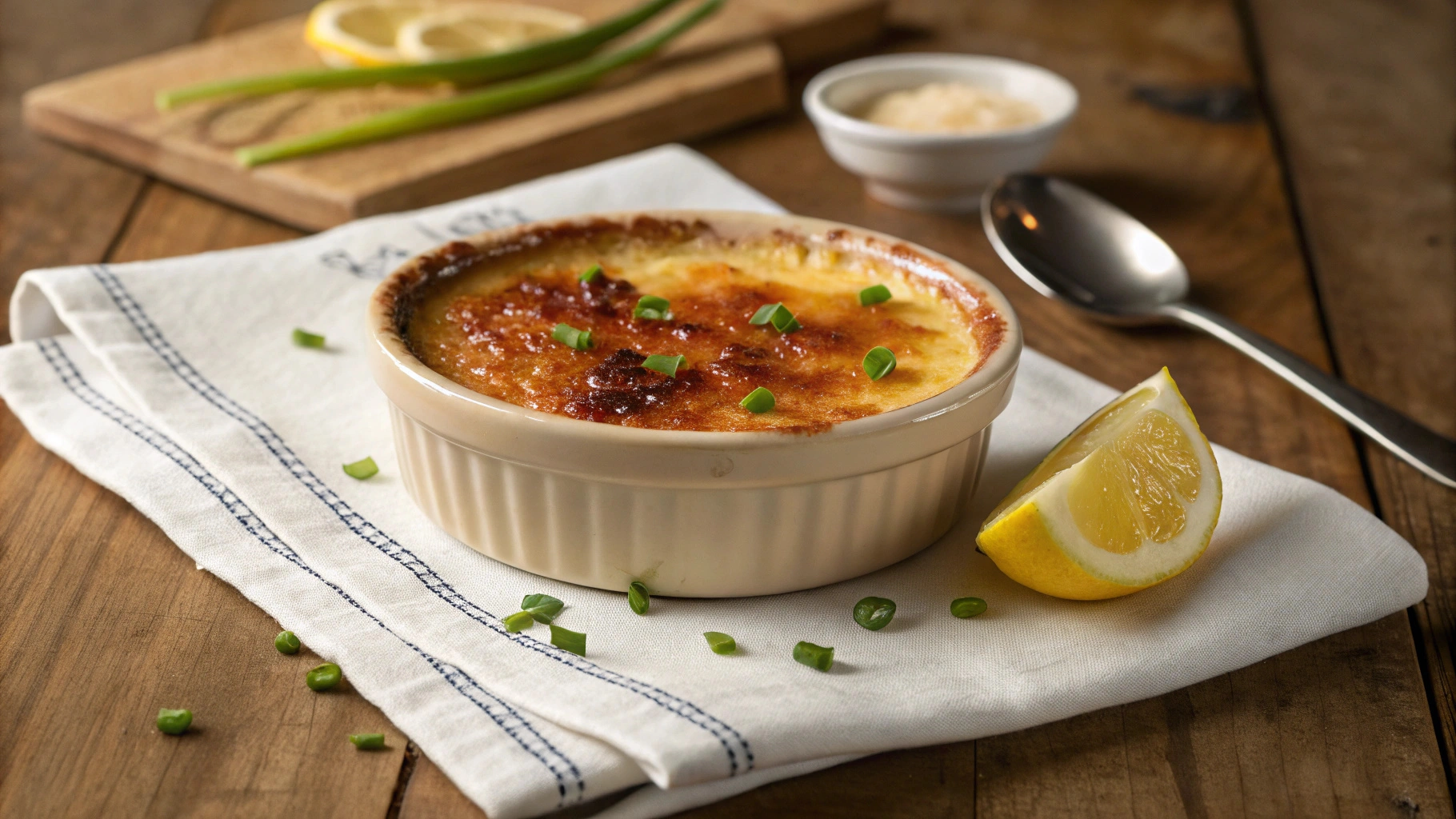Introduction
If you’re looking to impress with a dish that’s both elegant and delicious, crab brulee might just be the culinary masterpiece you need. This savory twist on the classic crème brûlée combines the creamy richness of custard with the sweet and delicate flavors of crab, creating a dish that’s as indulgent as it is unique. In this article, we’ll guide you through everything you need to know about making the perfect crab brulee recipe. From selecting the best crab meat to mastering the art of caramelizing sugar, every step is designed to elevate your cooking game. Let’s dive into the world of seafood sophistication!
Introduction to Crab Brulee Recipe
What is Crab Brulee?
Crab brulee is a savory adaptation of the classic French dessert crème brûlée. Instead of a purely sweet custard, this dish incorporates fresh, succulent crab meat into a creamy, savory base. Topped with a caramelized sugar crust, it delivers an irresistible balance of sweet and savory flavors. It’s an appetizer that feels like a dessert but tastes like a luxurious seafood dish.
This culinary creation isn’t just a feast for the taste buds—it’s also a feast for the eyes. The glossy caramelized top and delicate garnishes make it a showstopper on any table. Whether you’re serving it at a dinner party or enjoying it as a decadent treat, crab brulee is guaranteed to leave an impression.
Origins: The Fusion of Crème Brûlée and Seafood
Crème brûlée, which translates to “burnt cream,” has its roots in 17th-century France. Traditionally, it was a sweet custard topped with a layer of hardened caramelized sugar. Over time, chefs around the world began experimenting with savory variations, blending the creamy texture with bold, unexpected ingredients. Adding seafood, particularly lump crab meat, takes this innovation to a whole new level.
The marriage of the delicate sweetness of crab and the buttery richness of custard results in a dish that feels indulgent yet balanced—a perfect representation of French-inspired seafood cuisine.
Why Crab is a Game-Changer
The secret to the crab brulee recipe’s magic lies in its main ingredient: fresh crab meat. Unlike other proteins, crab brings a natural sweetness and a soft, flaky texture that complements the velvety custard base. This harmonious blend of flavors elevates the dish from ordinary to extraordinary.
Moreover, crab is packed with nutrients, including omega-3 fatty acids and protein, making it as nourishing as it is delicious. When combined with the creamy custard and caramelized sugar topping, the result is a one-of-a-kind dish that tantalizes the taste buds and satisfies the soul.
Essential Ingredients for Crab Brulee

Fresh vs. Canned Crab: Pros and Cons
The cornerstone of a perfect crab brulee recipe is, unsurprisingly, the crab itself. Fresh crab meat, whether from Dungeness or blue crab, is the top choice for its delicate texture and natural sweetness. This freshness brings out the savory notes of the dish while complementing the creamy custard.
However, canned crab can be a convenient substitute. While it lacks the vibrant flavor of fresh crab, it works in a pinch. If you opt for canned crab, ensure it’s high-quality and packed in water to preserve its flavor. Regardless of your choice, the crab should be free of shells or cartilage to keep the custard silky smooth.
Must-Have Ingredients for the Custard Base
Creating a luscious custard base is a fine balance of ingredients. The essentials include:
- Heavy cream: Provides the rich, velvety texture.
- Egg yolks and a whole egg: Give the custard its creamy structure.
- Seasonings: A pinch of salt, freshly ground white pepper, and a hint of nutmeg bring subtle complexity.
- Granulated sugar: Used for the iconic caramelized topping.
Optional ingredients like a splash of cognac or grated Parmesan can elevate the dish’s depth of flavor. Don’t forget fresh chives or parsley for a pop of color and herbaceousness!
Optional Add-Ins for Enhanced Flavor
Want to go beyond the basics? Adding a tablespoon of cognac or sherry can introduce a layer of warmth to the custard. Parmesan or Gruyère cheese provides a slightly nutty undertone, while lemon zest can brighten the entire dish.
For more seafood inspiration, check out The Ultimate Guide to Cooking King Salmon for tips on complementing seafood flavors.
Kitchen Tools You’ll Need for Your Crab Brulee Recipe
Basic Tools for Preparation
The right tools make all the difference when creating a crab brulee recipe. Start with ramekins—individual serving dishes that ensure even cooking. A whisk is essential for blending the custard ingredients, and a fine-mesh strainer will catch any lumps, ensuring a silky finish.
You’ll also need a saucepan to heat the cream, a large baking dish for the water bath, and mixing bowls for combining ingredients. These staples keep the process straightforward and fuss-free.
Advanced Gadgets for a Pro Finish
To achieve the dish’s signature caramelized topping, a kitchen torch is a must-have. This handy tool allows precise control when browning the sugar layer. An instant-read thermometer is also invaluable, ensuring your custard reaches the ideal temperature without curdling.
For a professional touch, use a digital kitchen scale to measure ingredients with precision. This guarantees consistency and perfection in every batch.
Having these tools on hand transforms the process into an enjoyable culinary experience, making your crab brulee both fun to prepare and delightful to serve.
How to Prepare the Perfect Custard Base for a Crab Brulee Recipe
Step-by-Step Guide to Mixing Ingredients
The custard base is the heart of any crab brulee recipe, blending creamy richness with delicate crab flavors. Here’s how to nail it:
- Whisk the eggs: Start by beating the egg yolks and the whole egg until smooth and slightly frothy. This step ensures your custard has the right structure.
- Heat the cream: Warm the heavy cream in a saucepan over medium heat until it just begins to simmer. Do not let it boil, as overheating can alter the texture.
- Temper the eggs: Gradually add the warm cream to the eggs, whisking constantly to prevent scrambling. This step requires patience but guarantees a silky custard.
- Incorporate seasonings: Stir in salt, white pepper, and a dash of nutmeg for subtle warmth. Fold in your prepared crab meat gently to avoid breaking it apart.
Tips for Avoiding Common Mistakes
- Don’t skip tempering; adding hot cream too quickly can cook the eggs.
- Strain the custard mixture through a fine-mesh sieve before pouring it into ramekins. This removes any lumps for a flawless texture.
- Avoid overmixing, as this introduces air bubbles, which can disrupt the creamy consistency.
Temperature Control: Key to Smooth Custard
Baking the custard evenly is crucial. Place the filled ramekins in a water bath to insulate them during baking. Set your oven to 320°F (160°C) and bake for 35–40 minutes. Use an instant-read thermometer to check the internal temperature—it should reach 175°F (79°C).
Let the custards cool at room temperature before chilling them in the refrigerator for at least 3–4 hours. Proper temperature management ensures a custard that’s rich and creamy every time.
Mastering the Caramelization Process for the Crab Brulee Recipe

Choosing the Right Sugar for Caramelizing
The sugar topping is what gives crab brulee its iconic crunch. Granulated sugar is the gold standard, melting evenly into a smooth, glossy crust. For added depth, you can experiment with brown sugar, though it burns more quickly. Turbinado or Demerara sugar offers a thicker, crunchier finish but requires careful attention during caramelization.
Torch Techniques for Even Browning
Using a kitchen torch is the easiest way to achieve a perfectly caramelized crust. Hold the torch 2–3 inches away from the sugar layer and move it in slow, circular motions. This method ensures even browning without burning any spots. For an extra-thick crust, sprinkle a second layer of sugar and repeat the process.
If you don’t have a torch, you can use your oven’s broiler. Place the ramekins on a baking sheet and broil on high for 1–2 minutes. Watch closely, as the sugar can burn quickly under high heat.
Achieving the Perfect Crack Without Overcooking
Once caramelized, allow the sugar topping to cool for about 1–2 minutes before serving. This brief pause helps the crust harden to perfection, creating that satisfying crack when tapped with a spoon.
For more culinary inspiration, explore recipes like The Ultimate Guide to Cooking King Salmon, which offers additional tips for mastering seafood dishes.
Presentation and Pairing

Serving Suggestions for Maximum Elegance
When it comes to a crab brulee recipe, presentation can elevate the dish from impressive to unforgettable. Serve the brulee in individual ramekins for a refined touch, ensuring each guest enjoys their own portion. Before serving, garnish with finely chopped chives or parsley for a pop of color.
To add more flair, pair the ramekins with citrus-dressed microgreens or toasted brioche points. These accompaniments complement the dish’s creamy richness with fresh, crisp textures. For a family-style option, prepare a larger brulee in a shallow dish, and let everyone scoop out their servings.
Always serve crab brulee immediately after caramelizing the sugar. This ensures the crust stays crisp, creating a delightful contrast to the smooth custard beneath.
Pairing Crab Brulee with Wine and Sides
The richness of crab brulee pairs beautifully with light, crisp wines. White Burgundy, Champagne, or Chablis are excellent choices, cutting through the custard’s creaminess and enhancing the crab’s natural sweetness. If you prefer non-alcoholic options, sparkling water with a splash of citrus works wonderfully.
For sides, consider a simple arugula salad tossed in a lemon vinaigrette or roasted asparagus. These light, fresh flavors balance the luxurious brulee, creating a well-rounded meal.
Make-Ahead Tips and Storage for Your Crab Brulee Recipe
How to Prepare the Custard in Advance
The beauty of a crab brulee recipe is its versatility. You can prepare the custard base ahead of time, saving effort on the day you plan to serve it. Mix and strain the custard mixture, and store it in an airtight container in the fridge for up to 24 hours. When ready, pour it into ramekins, bake, and chill as usual.
You can also assemble the brulees (custard and crab) up to 12 hours in advance, keeping them covered and refrigerated until it’s time to caramelize the sugar. This approach ensures a fresh, restaurant-quality finish without last-minute stress.
Proper Refrigeration Techniques
Refrigeration is key to maintaining the silky texture of your crab brulee. Cover the ramekins tightly with plastic wrap to prevent moisture or odors from affecting the custard. Store them at 40°F (4°C) or lower for optimal freshness.
Reheating and Serving Freshly Made Brulee
If your brulees have been refrigerated, let them sit at room temperature for about 30 minutes before caramelizing the sugar. Avoid reheating the custard directly, as this can alter its texture. Instead, focus on serving it with a freshly caramelized topping for the best experience.
These tips make it easy to serve crab brulee at its peak, ensuring every bite is as delicious as intended.
FAQs About the Crab Brulee Recipe
What Makes Crab Brulee Unique?
Crab brulee stands out because it’s a fusion of sweet and savory flavors, blending the creamy custard of traditional crème brûlée with the delicate sweetness of crab. This dish is an elegant appetizer or a luxurious brunch option, perfect for anyone who enjoys seafood with a twist.
The caramelized sugar topping adds an unexpected crunch, creating a delightful contrast to the custard’s velvety texture. It’s this balance of flavors and textures that makes crab brulee a showstopping addition to any meal.
How to Substitute Ingredients Without Compromising Taste
Running low on certain ingredients? Don’t worry! You can make substitutions while still keeping the essence of your crab brulee recipe. Instead of heavy cream, try half-and-half for a slightly lighter custard. If fresh crab isn’t available, high-quality canned crab can work in a pinch—just be sure to drain it well.
For a different flavor profile, swap nutmeg for a pinch of cayenne pepper to add subtle heat. While these adjustments may alter the flavor slightly, they’ll still preserve the dish’s integrity.
Can You Freeze Crab Brulee?
While freezing is not ideal for crab brulee due to its custard base, you can freeze the uncooked custard for up to a month. When ready to use, thaw it in the refrigerator overnight, then bake as directed. Avoid freezing the caramelized topping, as it loses its crispness when thawed.
How to Avoid Common Pitfalls?
To ensure your crab brulee recipe turns out perfectly:
- Use fresh, high-quality crab meat for the best flavor.
- Temper the eggs carefully to avoid scrambling.
- Keep a close eye on the caramelization process to prevent burning the sugar topping.
Expert Tips for Restaurant-Quality Crab Brulee
Secrets to Silky Custard and Perfect Caramelization
The foundation of a restaurant-quality crab brulee recipe lies in the custard. Always use fresh, rich ingredients, and don’t rush the mixing process. Straining the custard ensures it’s free of lumps, while baking it in a water bath prevents cracking or overcooking.
For the caramelized topping, granulated sugar works best. Use a kitchen torch to achieve even browning, holding it at a steady distance and moving in circles. For a thicker, crunchier crust, caramelize two layers of sugar, letting the first one cool before adding the second.
Presentation Tips from Top Chefs
Professional chefs know that presentation matters as much as flavor. Serve crab brulee in uniform ramekins, and garnish with fresh herbs like chives or parsley. For an extra touch, add a sliver of lemon zest or edible flowers to enhance the visual appeal.
Pair your dish with crisp white wine or a light salad for an elegant meal. These small details not only elevate the dish’s look but also enhance the dining experience.
Conclusion: Why Crab Brulee is a Must-Try
The Appeal of Savory and Sweet Fusion
A well-crafted crab brulee recipe is more than just a dish—it’s an experience. Combining the velvety smoothness of custard with the delicate, natural sweetness of crab creates a harmonious blend of flavors that’s hard to resist. The caramelized sugar topping adds the perfect finishing touch, balancing savory and sweet with a delightful crunch.
This unique fusion makes crab brulee an exceptional choice for special occasions or anytime you want to impress your guests. Whether served as a luxurious appetizer or the centerpiece of a brunch spread, its versatility and elegance never fail to shine.
A Dish to Elevate Any Occasion
From its visually stunning presentation to its unforgettable taste, crab brulee is the ultimate crowd-pleaser. It’s not just a dish—it’s a conversation starter, the kind of recipe that leaves a lasting impression. And while it may seem sophisticated, the step-by-step process is approachable for home cooks looking to try something new.
So, why not elevate your next dinner party or celebration with this indulgent masterpiece? With the right ingredients, a little patience, and attention to detail, you can create a restaurant-worthy crab brulee that’s sure to delight every palate.

